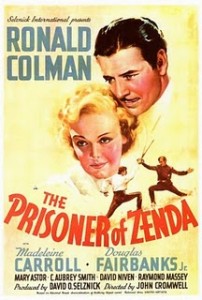But possibly better music comes ahead of it, in Prince of Foxes. It’s another historical adventure, the type of film where Newman seems at his absolute best, as in Captain from Castile and The Mark of Zorro. Besides being my favorite score on the disc—and the longest track at thirteen minutes, Prince of Foxes contains, I believe, the best music as well, including, yep, another march. Besides the expected flamboyance, Alfred Newman has the chance to create, if not historically accurate Renaissance dances, at least a highly convincing pastiche of that period’s music for the “Garden Fête.” The best of all, perhaps, is the main title, with its opening blend of, primarily, pounding timpani, brass and cymbal crashes, pursuant to an heroic horn melody.
 As in most historical films, those all-necessary trumpets and horns launch the main title of The Prisoner of Zenda—the 1937 original with Ronald Colman and Madeleine Carroll. This same music was reused for an identical remake, shot for shot, in 1952 with Stewart Granger and Deborah Kerr. As so often with remakes, it wasn’t as good as the original. At that first preview screening of Gone with the Wind at the Riverside theater, it was the 1937 Zenda music that David O. Selznick dubbed in until Steiner could finish the actual score.
As in most historical films, those all-necessary trumpets and horns launch the main title of The Prisoner of Zenda—the 1937 original with Ronald Colman and Madeleine Carroll. This same music was reused for an identical remake, shot for shot, in 1952 with Stewart Granger and Deborah Kerr. As so often with remakes, it wasn’t as good as the original. At that first preview screening of Gone with the Wind at the Riverside theater, it was the 1937 Zenda music that David O. Selznick dubbed in until Steiner could finish the actual score.
The next-to-longest track, and a rival for the best music on the disc, is another extended suite, now from Wuthering Heights. All is wonderfully arranged, again by Fred Steiner, and the wordless chorus adds a poignant melancholy to the music. It would be interesting to compare Newman’s work with Korngold’s in Devotion, a movie with the same source; Devotion is about all three Brontë sisters—Emily, who wrote Wuthering Heights, and sisters Anne and Charlotte. Such a comparison might begin with the two composers’ approach to the edifice of Wuthering Heights itself: Korngold’s exultant, Newman’s more subtle; and then there are the moors, which both men depict in their respective ways. The only music duplicated between these two Newman albums is “Cathy’s Theme.”
The remaining score in this album is deliberately held until last, an almost nine-minute suite from Dragonwyck. The main title contains at least three themes, though the first is surprisingly less stark here than in the actual film track. Soon after the main title, in the opening sequence, the music timidly suggests what seems to be a sorrowful waltz but is interrupted by a delicious brass chorale, then an English folk song-like melody—and very English sounding—which is duly passed among the woodwinds in Vaughan Williams-like bucolic tranquility (I’m reminded of the opening section of his Norfolk Rhapsody No. 1).
The waltz returns in full bloom, gliding quietly, and proceeds through various changes, always with that tinge of melancholy. This is, I think, the highlight of the score. The music depicting the Dragonwyck mansion is the same passage mentioned in that partial summary of the plot, beginning darkly, ominously in the lower registers of the orchestra, erupting in a mighty crescendo, with cymbals and ending in a loud, inescapable cadence. Not the end, the suite continues mournfully with material already heard, now a slowed down hint of the waltz, becoming, it seems, sadder than before. Hovering suspensefully, a crescendo, then the final cadence. Yes, a rewarding experience, indeed.
It’s not necessary to be limited to only one of these CDs. As there is essentially no duplication of music between them, buy both. The slight superiority of Gerhardt’s London players and the wider variety of their selections (the Koch is essentially historical films) is proportionately offset by Kaufman’s longer excerpts. Total time shouldn’t be a consideration; despite the improved capacity of the CD over the 1974 LP, the Koch has, ridiculously, only about fifty minutes.
A sad note, though. Having again glanced over the liner notes for the Koch disc, I’ve examined more closely a younger photo of Alfred Newman, probably from the early 1940s. He’s at the piano and, affixed above the keyboard, a draftsman-like easel where rests a manuscript in progress, an array of pencils and a stop watch. In one hand a pencil, possibly a colored pencil, in the other, wedged between his index and middle fingers, is a . . . cigarette.
One thought to “Dragonwyck (1946) with Gene Tierney”